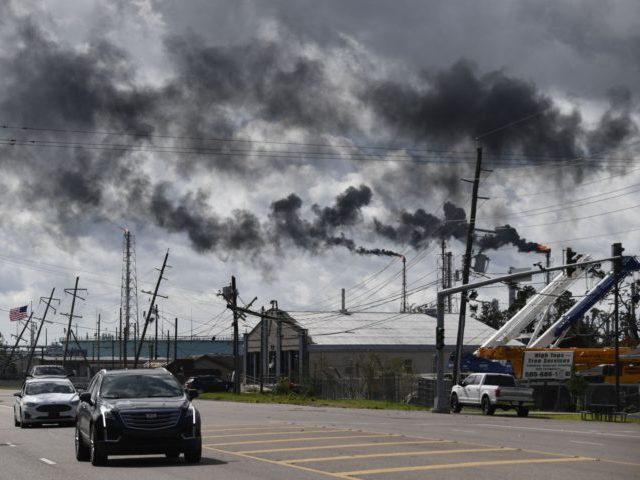The oil and gas industry infrastructure in the Gulf of Mexico suffered extensive damage from Hurricane Ida, which made landfall Sunday as a Category 4 storm.
It could take weeks to assess the damage, with repairs delayed by the loss of power after “catastrophic” damage was done to Louisiana’s power grid, utilities officials said.

An aerial view of flood waters from Hurricane Delta surrounding structures destroyed by Hurricane Laura on October 10, 2020 in Creole, Louisiana. Hurricane Delta made landfall as a Category 2 storm in Louisiana initially leaving some 300,000 customers without power. (Mario Tama/Getty Images).
Reuters reported on the efforts to restart oil and gas production in the Gulf, which will translate into higher prices at the pump:
Hundreds of oil production platforms remained evacuated and nearly 1.1 million homes and businesses in Louisiana and Mississippi were without power on Monday afternoon. Refineries in Norco and Belle Chasse, Louisiana, remained swamped a day after the storm passed, images showed.
Entergy Corp, the largest power utility in Louisiana, warned there was “catastrophic” damage to transmission lines. One tower that provides power collapsed at the height of the storm and its power lines fell into the Mississippi River, the utility said.
Exxon Mobil Corp halted operations at its 520,000 barrel per day (bpd) Baton Rouge oil processing and chemical complex due to lack of power and raw materials, a spokesperson said. Phillips 66 will conduct a post-storm assessment at a refinery in a hard-hit area of Louisiana “when it is safe to do so,” said spokesman Bernardo Fallas.
“You can’t simply flip the switch” and resume production of a refinery, Robert Yawger, director of energy futures at Mizuho Securities, said. He added that restarts are complicated and dangerous.
“My observation is two to four weeks,” Yawger said.
The tracking firm GasBuddy said the outages could push retail gasoline prices up 5 to15 cents per gallon until processing returns to normal.
Colonial Pipeline Co, the largest U.S. fuel pipeline network, said in the Reuters report that it hopes to start pumping gasoline and diesel on closed lines from Houston to Greensboro, North Carolina, on Monday evening. The network supplies almost half the gasoline consumed along the U.S. East Coast.
Reuters reported that oil companies have begun surveying offshore platforms for damages.
”It will take some days to get a clear picture of possible impact,” Ola Morten Aanestad, a spokesperson for Equinor ASA, which evacuated its Titan platform and halted Gulf production, said.
“The closures included Louisiana Offshore Oil Port (LOOP), the largest privately owned crude export and import terminal in the United States,” Reuters reported.
Follow Penny Starr on Twitter or send news tips to pstarr@breitbart.com.

COMMENTS
Please let us know if you're having issues with commenting.